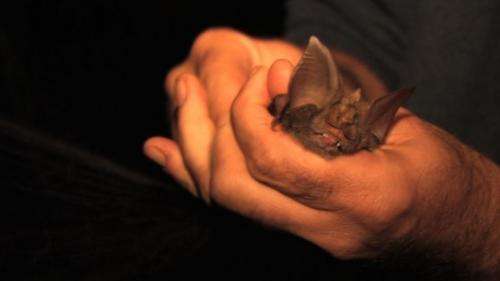DNA and sonar data used in discovery of four new species of Horseshoe bat

(Phys.org)—A new multidisciplinary study on the enigmatic large Horseshoe bat – found widespread throughout South and East Africa – has revealed that instead of just one species as previously believed, the bat is in fact five different species, four of which have just been classified for the first time following their discovery.
The discoveries were published yesterday in PLoS ONE, with the investigation led by bat experts and evolutionary geneticists from the University of Venda, Stellenbosch University, the University of Swaziland, the University of KwaZulu Natal, and the University of Cambridge.
It was previously thought that there was only one type of large horseshoe bat, Hildebrandt's Horseshoe bat, although a series of discoveries beginning back in 1988 have led researchers to long suspect that the bat was in fact a complex group of different species – known as a 'cryptic' species.
But hard evidence had eluded scientists until now, as modern technology, combined with a multidisciplinary approach, has allowed researchers to solve the riddle of these cryptic species for the first time.
The researchers compared key characteristics of the bats, including sonar calls, skull shape, genitalia and – critically – divergence in DNA sequences to diagnose and classify the four new species.
It is believed that this combination of techniques, the consilience of evidence, could be used to unlock other cryptic species in the future – such as certain types of chameleon, frog and shark – suggesting that current predictions of global biodiversity might be too low.
Researchers discovered correlations between altitude and size in the bats, with gigantism occurring in high habitats and dwarfism at lower altitudes due to variations in climate temperature. To explain the evolution of these differences, they invoked the relationship between skull size and sonar frequency – the larger bats call at lower frequencies.
One of the four new species of bat was discovered by Dr Julian Bayliss from the Conservation Science Group at Cambridge's Department of Zoology, and has been named after Mount Mabu – the largest rainforest in southern Africa.
The rainforest in northern Mozambique was only discovered by Bayliss in 2005, who came across it while scanning the digital satellite application Google Earth. A field visit was then organised by Bayliss and Claire Spottiswoode to ground truth the site, in preparation for a RBG Kew Darwin Initiative project to assess the biodiversity of the high altitude mountains in northern Mozambique.
Since this discovery, Bayliss has worked extensively at Mount Mabu – home of the new bat species. The rainforest has proved to be a vast treasure trove of previously undiscovered wildlife, and conservationists are fighting to get the land protected.
"We chose this bat's name to draw attention to the serious threat to the unique biodiversity isolated on the montane forest islands in northern Mozambique, notably Mount Mabu and Mount Inago," said Bayliss.
"None of these landforms lie within formally protected areas, and are all undergoing major habitat degradation and destruction from human activities such as timber harvesting and agricultural practices. The more endemic species we can attribute to the area, the greater the justification to preserve."
The DNA analysis critical to distinguishing the new species has shown that they are relatively old and evolved in the Pliocene Epoch over the past two to five million years.
"We suggest that because of climatic extremes and geomorphological changes across eastern Africa, the ancestors of these species were isolated on either mountain tops or along river valleys," said Dr Woody Cotterill, from Stellenbosch University.
Two of the species have been named in honour of dedicated Southern African conservationists – Ms Lientjie Cohen, a scientist of the Mpumalanga Tourism and Parks Agency in South Africa, and the late founder of Zimbabwe's museums, Dr. Reay Smithers, author of Southern Africa's most comprehensive mammal anthology.
The new species are as follows:
Cohen's Horseshoe Bat (Rhinolophus cohenae)
Smithers' Horseshoe Bat (Rhinolophus smithersi)
The Mozambican Horseshoe Bat (Rhinolophus mossambicus)
The Mount Mabu Horseshoe Bat (Rhinolophus mabuensis).
Journal information: PLoS ONE
Provided by University of Cambridge
















